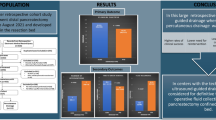Abstract
Purpose
The objective of this study was to characterize the clinical course and outcomes of children with pancreatic pseudocysts that were initially treated non-operatively or with percutaneous drainage.
Methods
A retrospective review of children with pancreatic pseudocysts over a 12-year period was completed. Categorical variables were compared using Fischer’s exact method and the Student’s t test was used to compare continuous variables. Analysis was done using logistic and linear regression models.
Results
Thirty-six children met the criteria for pancreatic pseudocyst and 33 children were treated either non-operatively or with percutaneous drainage. Of the 22 children managed non-operatively, 17 required no additional intervention (77 %) and five required surgery. Operative procedures were: Frey procedure (3), distal pancreatectomy (1), and cystgastrostomy (1). Eight of the 11 children treated with initial percutaneous drainage required no additional treatment (72 %). The other three children underwent distal pancreatectomy. Success of non-operative management or percutaneous drainage was not dependent on size or complexity of the pseudocyst Logistic regression did not identify any patient demographic (gender, age, and weight), etiologic (trauma, non-traumatic pancreatitis) or pseudocyst characteristic (size, septations) that predicted failure of non-operative therapy.
Conclusions
In children, pancreatic pseudocysts can frequently be managed without surgery regardless of size or complexity of the pseudocyst. When an intervention is needed, percutaneous drainage can be performed successfully, avoiding the need for major surgical intervention in the majority of patients.


Similar content being viewed by others
References
de Blaauw I, Winkelhorst JT, Rieu PN, van der Staak FH, Wijnen MH, Severijnen RS, van Vugt AB, Wijnen RM (2008) Pancreatic injury in children: good outcome of nonoperative treatment. J Pediatr Surg 43(9):1640–1643
Al-Hussaini A, Butzner D (2012) Therapeutic applications of octreotide in pediatric patients. Saudi J Gastroenterol 18:87–94
Karaguzel G, Senocak ME, Buyukpamukcu N et al (1995) A surgical management of the pancreatic pseudocyst in children: a long term evaluation. J Pediatr Surg 30:777–780
Vitas GJ, Sarr MG (1992) Selected management of pancreatic pseudo- cysts: operative versus expectant management. Surgery 111(2):123–130
Paul MD, Mooney DP (2011) The management of pancreatic injuries in children: operate or observe. J Pediatr Surg 46:1140–1143
Kouchi K, Tanabe M et al (1999) Nonoperative management of blunt pancreatic injury in childhood. J Pediatr Surg 34:1736–1739
Shilyansky J, Sena LM et al (1998) Nonoperative management of pancreatic injuries in children. J Pediatr Surg 33:343–349
Canty TG Sr, Weinman D (2001) Management of major pancreatic duct injuries in children. J Trauma 50:1001–1007
Makin E, Harrison P, Patel S, Davenport M (2012) Pancreatic pseudocysts in children. J Pediatr Gastroenterol and Nutr 55(5):556–558
Jazawi SF, Barth BA, Sreenarasimhaiah J (2011) Efficacy of endoscopic ultrasound-guided drainage of pancreatic pseudocysts in a pediatric population. Dig Dis Sci 56(3):902–908
Teh SH, Pham TH, Lee A, Stavlo PL, Hanna AM, Moir C (2006) Pancreatic pseudocyst in children: the impact of management strategies on outcome. J Pediatr Surg 41:1889–1893
Benifla M, Weizman Z (2003) Acute pancreatitis in childhood: analysis of literature data. J Clin Gastroenterol 37(2):169–172
Bass J, Di Lorenzo M, Desjardins JG et al (1988) Blunt pancreatic injuries in children: the role of percutaneous external drainage in the treatment of pancreatic pseudocysts. J Pediatr Surg 23(8):721–724
Ford EG, Hardin WD Jr, Mahour GH et al (1990) Pseudocysts of the pancreas in children. Am Surg 56(6):384–387
Jaffe RB, Arata JA Jr, Matlak ME (1989) Percutaneous drainage of traumatic pancreatic pseudocysts in children. AJR Am J Roentgenol 152(3):591–595
Burnweit C, Wesson D, Stringer D et al (1990) Percutaneous drainage of traumatic pancreatic pseudocysts in children. J Trauma Inj Infect Crit Care 30(10):1273–1277
Baron TH, Harewood GC, Morgan DE et al (2002) Outcome differences after endoscopic drainage of pancreatic necrosis, acute pancreatic pseudocysts, and chronic pancreatic pseudocysts. Gastrointest Endosc 56(1):7–17
Bradley EL III (1993) A clinically based classification system for acute pancreatitis. Summary of the international symposium on acute pancreatitis, atlanta, GA, September 11 through 13, 1992. Arch Surg 128(5):586–590
Warshaw AL, Rattner DW (1985) Timing of surgical drainage for pancreatic pseudocyst. Clin Chem criteria. Ann Surg 202(6):720–724
Wales PW, Shuckett B, Kim PC (2001) Long-term outcome after non- operative management of complete traumatic pancreatic transection in children. J Pediatr Surg 36:823–827
Author information
Authors and Affiliations
Corresponding author
Rights and permissions
About this article
Cite this article
Russell, K.W., Barnhart, D.C., Madden, J. et al. Non-operative treatment versus percutaneous drainage of pancreatic pseudocysts in children. Pediatr Surg Int 29, 305–310 (2013). https://doi.org/10.1007/s00383-012-3236-x
Accepted:
Published:
Issue Date:
DOI: https://doi.org/10.1007/s00383-012-3236-x




